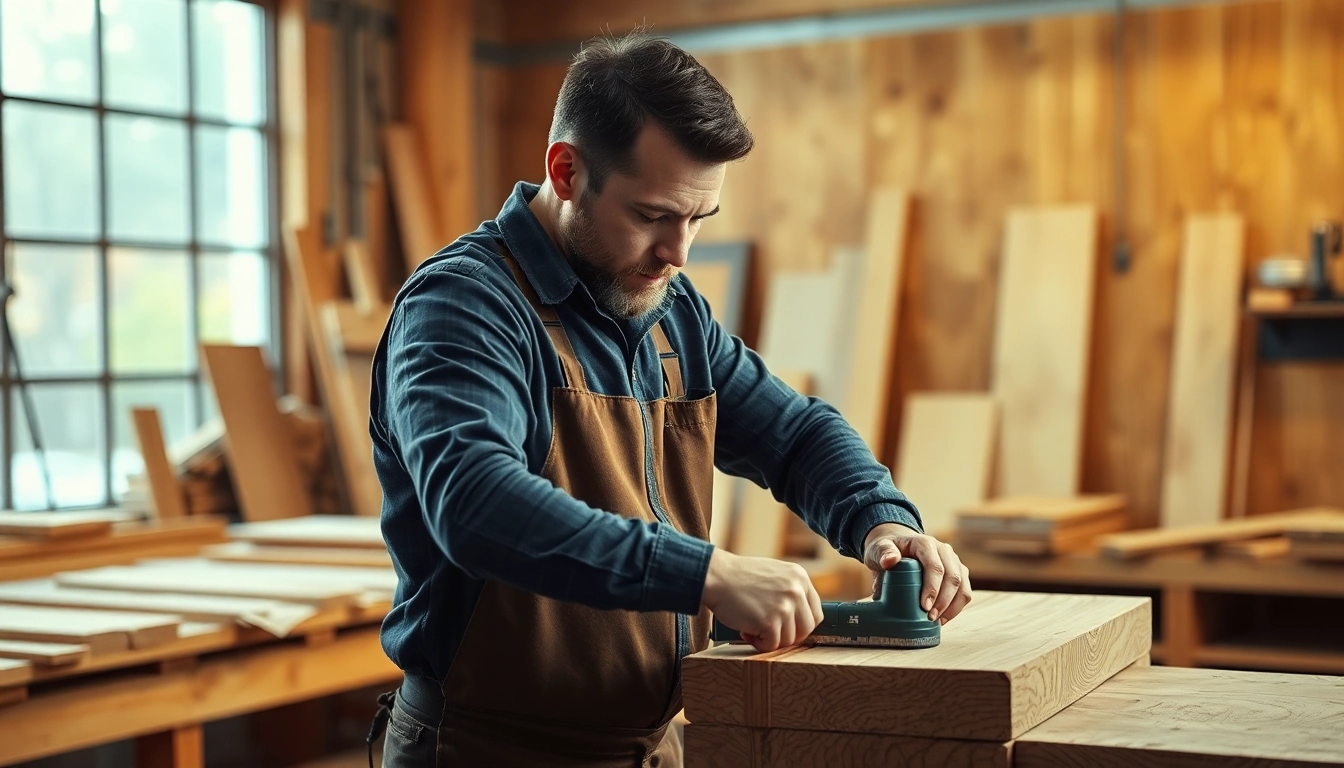Understanding the Role of a Carpenter
A Carpenter is a vital tradesperson within the construction and renovation industries. Their expertise lies in constructing, repairing, and installing building frameworks and structures made primarily from wood and other materials. Carpenters play an essential role from foundational phase to finishing touches, influencing the durability, functionality, and aesthetic appeal of residential, commercial, and industrial spaces. Recognizing the depth of a carpenter’s skills helps property owners, contractors, and aspiring tradespeople understand the importance of this craftsmanship in creating safe, beautiful, and sustainable environments.
1.1 What Traditions Define a Carpenter’s Skills
Historically, carpentry has roots dating back thousands of years, with traditions passed orally from master to apprentice. Core skills include precise measurement, effective use of hand tools and power tools, material selection, and joint installation techniques. Modern carpenters incorporate traditional craftsmanship with contemporary technology, emphasizing precision and efficiency. Despite evolving methods, the fundamental craftsmanship—shaping, cutting, and assembling—is timeless and vital in producing resilient structures.
1.2 Different Types of Carpenters and Specializations
Carpenters are classified into various specializations based on their focus and the scope of projects they handle. Key categories include:
- Rough Carpenters: Focused on structural framework, such as building walls, framing, and roofing.
- Finish Carpenters: Specialized in detailed work like cabinetry, molding, and trim work.
- Residential Carpenters: Work primarily on homes, including framing, staircases, and interior finishing.
- Commercial Carpenters: Engage in large-scale projects like malls, offices, and warehouses, handling complex frameworks and installations.
- Industrial Carpenters: Construct large structures like factories or bridges, often involving heavier materials.
1.3 Common Projects Carpenters Complete
Projects your local carpenter might undertake are diverse, ranging from installing kitchen cabinets and custom furniture to erecting entire building frameworks. They also handle siding, flooring, door installation, roofing, and even concrete formwork. For example, professionals skilled in residential carpentry may design and build custom cabinetry and outdoor decks, significantly enhancing a property’s value and functionality. Conversely, commercial carpenters take charge of structural steel framing for large skyscrapers or complex infrastructure projects, requiring advanced technical skills and familiarity with safety standards.
How to Choose the Right Carpenter for Your Project
2.1 Skills and Certifications to Look For
When selecting a carpenter, prioritize those with verified skills, relevant certifications, and memberships in professional associations such as the United Brotherhood of Carpenters and Joiners. Certifications like OSHA safety compliance and specialized training in modern materials or green building practices showcase professionalism and commitment to quality. Skilled carpenters often hold licenses, have completed apprenticeships, and keep their knowledge current through ongoing education. For complex projects, it’s advantageous to work with licensed professionals who adhere to safety and building codes, ensuring durability and compliance.
2.2 Evaluating Experience and Portfolio
Experience is a key indicator of a carpenter’s capability. Review their portfolio or request references from previous clients to assess the quality of their work, attention to detail, and adaptability to different project types. For instance, a portfolio showcasing a mix of residential renovations, custom furniture, and commercial framing demonstrates versatility. Industry experience also correlates with problem-solving skills, efficiency, and adherence to timelines. For high-stakes projects, consider hiring an experienced carpenter with a track record of successful project completions similar to yours.
2.3 Questions to Ask Before Hiring
To ensure you choose the best professional, prepare pertinent questions such as:
- What is your experience with projects similar to mine?
- Are you licensed and insured?
- Can you provide references or testimonials?
- What is your estimated timeline and cost for my project?
- How do you handle unforeseen issues or delays?
Asking these questions clarifies expectations, helps compare bids, and ensures you are engaging with a competent, reliable carpenter.
Cost and Pricing: What to Expect
3.1 Typical Hourly and Project Rates
The precise cost of carpentry work varies depending on location, project complexity, and the specialized skills required. Generally, the hourly rate for a skilled carpenter ranges from $40 to $200. The average falls around $75 to $125 per hour, with high-demand projects or experts commanding the upper end. For project-based pricing, costs can range from a few thousand dollars for smaller jobs like cabinetry to hundreds of thousands for large commercial structures. Understanding these rates helps homeowners and businesses budget accurately.
3.2 Factors Influencing Pricing
Several factors influence carpentry costs:
- Project Complexity: Intricate designs or custom work increase labor and material costs.
- Material Choices: Premium or exotic woods significantly raise expenses.
- Location: Urban areas with higher living costs tend to have elevated service charges.
- Timeline: Urgent deadlines often increase labor charges due to overtime.
- Technological Integration: Use of advanced tools or techniques may affect pricing.
3.3 Budgeting for Your Carpentry Project
Effective budgeting involves obtaining detailed quotes, setting aside contingency funds for unforeseen expenses, and clearly defining project scope. For extensive renovations, consider breaking the project into phases to manage cash flow and track progress. It’s advisable to get at least three bids from different carpenters to compare pricing and value. An oversight in budgeting can lead to delays or compromises, so comprehensive planning is essential for successful project completion.
Best Practices in Carpentry Work and Material Selection
4.1 Choosing Quality Materials for Durability
The longevity and aesthetic appeal of carpentry work hinge on material quality. For framing and structural components, choosing seasoned, pressure-treated lumber minimizes warping and rot. Interior finishes benefit from high-grade plywood, MDF, or hardwoods like oak, maple, or cherry for cabinetry and trim. When selecting materials, consider environmental factors: moisture-resistant materials for bathrooms or exteriors, and sustainable options for eco-conscious projects. Consulting with experts or suppliers can yield insights into the best materials for your specific application, ensuring durability and value.
4.2 Safety Standards and Efficient Workflow
Implementing safety standards such as OSHA regulations minimizes workplace injuries and liability. Proper use of personal protective equipment, secure scaffolding, and adequate ventilation are paramount. An organized workspace and clear communication streamline workflow, reducing errors and material waste. For example, pre-measuring and cutting materials before assembly minimize on-site errors, and using modern power tools enhances precision and efficiency. Continuous safety training and adherence to codes foster an environment where craftsmanship meets safety excellence.
4.3 Incorporating Modern Techniques and Tools
Embracing technological advancements enhances productivity and precision. Tools like CNC routers, laser measuring devices, and 3D modeling software allow for detailed designs and exact cuts. Modern framing techniques, such as prefabrication, reduce on-site labor and improve quality control. Eco-friendly innovations, including low VOC finishes and sustainable materials, help meet green building standards and appeal to environmentally conscious clients. Staying current with industry trends and integrating smart tools positions a carpenter at the forefront of traditional and modern craftsmanship.
Maximizing Value with Your Carpentry Investment
5.1 Enhancing Home Value and Aesthetic
Skilled carpentry can significantly boost a property’s market value. Well-crafted features such as custom cabinetry, crown molding, and hardwood floors create visual appeal and a sense of craftsmanship. These elements not only elevate aesthetics but also contribute to structural integrity and longevity. For example, a bespoke staircase can serve as a focal point, adding both beauty and functionality. Invest in quality carpentry to ensure your space remains timeless, attractive, and resists depreciation.
5.2 Maintenance and Longevity Tips
Proper maintenance extends the lifespan of carpentry work. Regular cleaning, inspection for signs of damage or wear, and timely repairs prevent costly issues. Using low-maintenance finishes and sealants can simplify upkeep, especially in high-traffic areas or outdoor environments. Educate yourself on the specific needs of different materials—wood needs protection from moisture, while paints and finishes require reapplication over time. Adopting preventative strategies safeguards your investment, ensuring the beauty and function endure for decades.
5.3 Connecting with Skilled Carpenters for Long-Term Projects
Building relationships with reputable carpenters can lead to long-term advantages, such as priority service, better pricing, and trusted advice. Look for professionals who demonstrate transparency, uphold safety standards, and are committed to quality. Consider forming partnerships with local carpentry firms for ongoing maintenance or expansion projects. These collaborations often result in more cohesive, efficient workflows and consistent standards, culminating in projects that satisfy both aesthetic and structural expectations.



